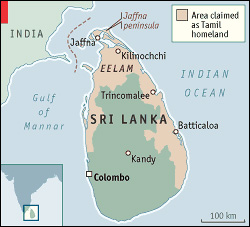 Current civil war theory suggests that civil wars are tough to end with negotiated settlements; victory tends to stick better. Attempts to intervene from outside have largely failed to end the 25-year-old Sri Lanka civil war, in which the LTTE (popularly known as Tamil Tigers) have fought for independence from Sri Lanka.
Current civil war theory suggests that civil wars are tough to end with negotiated settlements; victory tends to stick better. Attempts to intervene from outside have largely failed to end the 25-year-old Sri Lanka civil war, in which the LTTE (popularly known as Tamil Tigers) have fought for independence from Sri Lanka.Sri Lanka's not a big state, nor a rich one--the disruption has been devastating to its population, and quite a thorn in the side of India (who has a large Tamil minority in its southeast). The rebels, who claim a large swath of northern coastal territory in Sri Lanka as "Tamil homeland," are on the US and EU terror lists for their treatment of civilians during the conflict. But to be truly fair, the Colombo government hasn't been much nicer.
The rebels have been surprisingly well-armed during the entire ordeal, able to strike Sri Lankan military installations multiple times in the last year with a fighter-bomber wing that the Sri Lankans have struggled to destroy. But a renewed offensive, in which the Sri Lankan military has taken heavy casualties, recaptured the central-eastern part part of th
 e country and the critical Jaffna Pennensula at the northernmost part of the island. The rebels have been collapsed to a defensive pod (the pink shown in the picture to the right), and have held strong. But a recent three-day battle with heavy casualties has broken the rebel front lines on the north-facing side of the Tamil stronghold.
e country and the critical Jaffna Pennensula at the northernmost part of the island. The rebels have been collapsed to a defensive pod (the pink shown in the picture to the right), and have held strong. But a recent three-day battle with heavy casualties has broken the rebel front lines on the north-facing side of the Tamil stronghold.The territory is jungle, and thus very friendly to the local Tamils, who are likely able to move rather freely throughout the area; this will make fighting here not only tought, but a Vietnam kind of tough. The government may have to resort to seriously heavy-handed tactics througout the last phases of the operation to smoke out the Tigers once and for all--even if this will make reconstruction and reintegration more difficult.
I mean to emphasize that there will not be a quick and easy victory in store for the Sri Lankan military-- but the momentum is certainly theirs, and their casualty-acceptance has gone up significantly as morale increases. The ability of the Tigers to launch air strikes or move in major formations without being hit by Sri Lankan air power has diminished significantly, and the Sri Lankan military should begin to assume flanking operations on one side of the front if it has kept reserves properly ready. It must sieze the initiative.
If it does not, the Tamils may resort to trying to stretch the conflict out through a Maoist insurgency--of the style used by the Chinese Red Army in the 1930's, the Viet Cong in the 1960's. Such a style of asymmetric warfare has a surprisingly high rate of success against local governments when the purpose is to stretch their supply lines, decrease their morale, and generally increase costs.
That said, the likelihood that the Tigers will be able to turn the tide in full at this point is very low. They do not have a large population to continually draw fighters from, and their area of operation has shrunk so low that they will struggle to avoid decisive battles like this most recent one--Maoist-style insurgencies can only succeed if the rebels have the ability to continually retreat and regroup--hit-and-run tactics against patrols between long-term rests in relatively friendly territory are essential in being able to carry out a protracted conflict. The Tamils' ability to do that is quickly shrinking; the Sri Lankan military's superior manpower, training, and resources should bring them victory in the next few months.
No comments:
Post a Comment